Analysis of Health and Medical Practices in Australia
VerifiedAdded on 2021/02/21
|12
|3459
|82
Essay
AI Summary
This essay provides a comprehensive analysis of various aspects of health and healthcare in Australia. It begins by examining post-modernist perspectives and their implications for health practice, followed by an investigation into the persistent issue of Indigenous health disparities, despite increased funding. The essay then delves into the sociological implications of psychiatry, the benefits and limitations of e-health, and the influence of ideology and politics on health outcomes, using the Pharmaceutical Benefits Scheme as an example. It also discusses functionalist theory, medical dominance within the Australian context, and the concept of discourse in health and biomedicine. Finally, it addresses multiculturalism and the differing health needs of immigrants and refugees compared to those born in Australia. The essay draws on sociological theories and examples to illustrate its arguments, providing a multifaceted understanding of the Australian healthcare system.
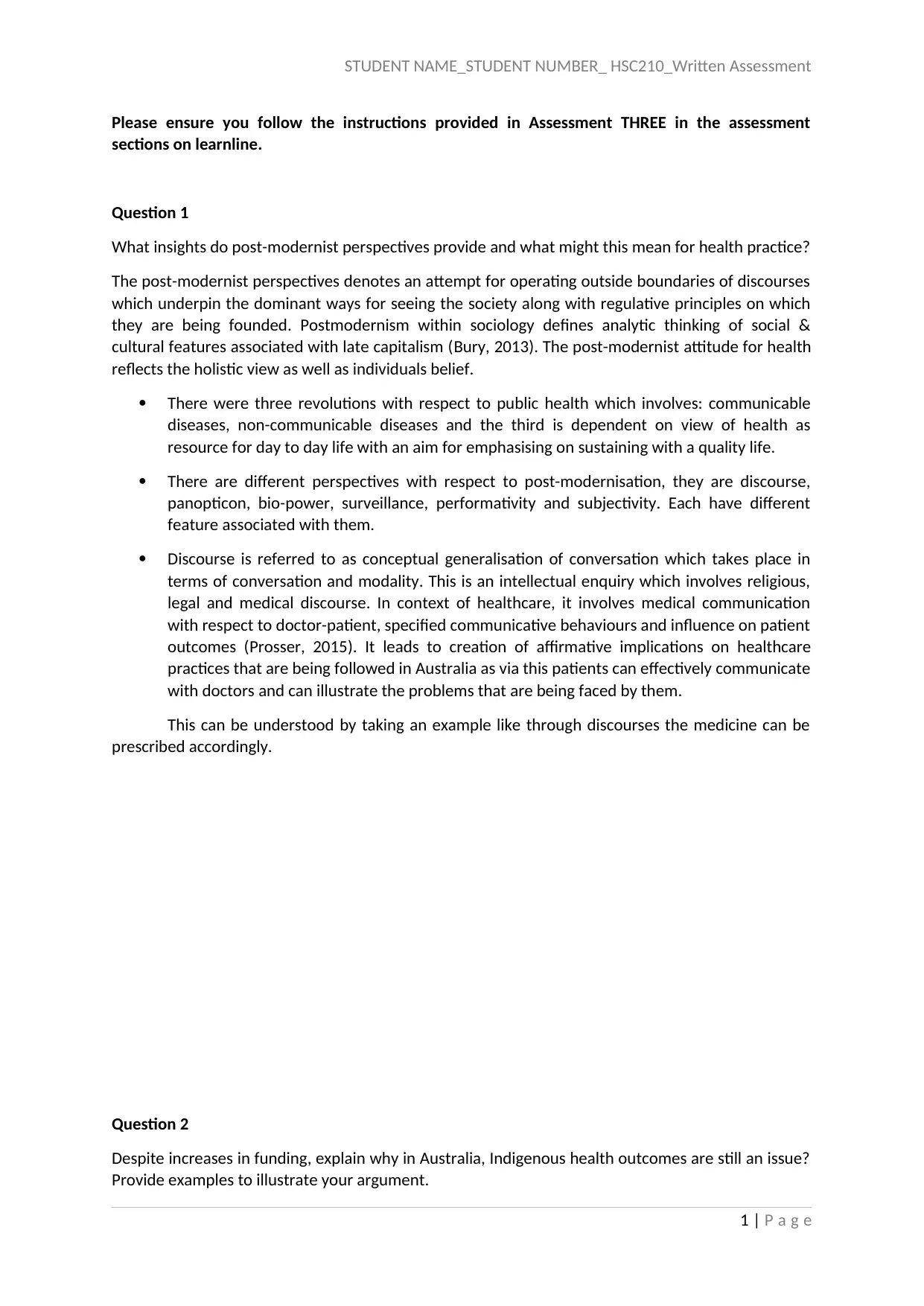
STUDENT NAME_STUDENT NUMBER_ HSC210_Written Assessment
Please ensure you follow the instructions provided in Assessment THREE in the assessment
sections on learnline.
Question 1
What insights do post-modernist perspectives provide and what might this mean for health practice?
The post-modernist perspectives denotes an attempt for operating outside boundaries of discourses
which underpin the dominant ways for seeing the society along with regulative principles on which
they are being founded. Postmodernism within sociology defines analytic thinking of social &
cultural features associated with late capitalism (Bury, 2013). The post-modernist attitude for health
reflects the holistic view as well as individuals belief.
There were three revolutions with respect to public health which involves: communicable
diseases, non-communicable diseases and the third is dependent on view of health as
resource for day to day life with an aim for emphasising on sustaining with a quality life.
There are different perspectives with respect to post-modernisation, they are discourse,
panopticon, bio-power, surveillance, performativity and subjectivity. Each have different
feature associated with them.
Discourse is referred to as conceptual generalisation of conversation which takes place in
terms of conversation and modality. This is an intellectual enquiry which involves religious,
legal and medical discourse. In context of healthcare, it involves medical communication
with respect to doctor-patient, specified communicative behaviours and influence on patient
outcomes (Prosser, 2015). It leads to creation of affirmative implications on healthcare
practices that are being followed in Australia as via this patients can effectively communicate
with doctors and can illustrate the problems that are being faced by them.
This can be understood by taking an example like through discourses the medicine can be
prescribed accordingly.
Question 2
Despite increases in funding, explain why in Australia, Indigenous health outcomes are still an issue?
Provide examples to illustrate your argument.
1 | P a g e
Please ensure you follow the instructions provided in Assessment THREE in the assessment
sections on learnline.
Question 1
What insights do post-modernist perspectives provide and what might this mean for health practice?
The post-modernist perspectives denotes an attempt for operating outside boundaries of discourses
which underpin the dominant ways for seeing the society along with regulative principles on which
they are being founded. Postmodernism within sociology defines analytic thinking of social &
cultural features associated with late capitalism (Bury, 2013). The post-modernist attitude for health
reflects the holistic view as well as individuals belief.
There were three revolutions with respect to public health which involves: communicable
diseases, non-communicable diseases and the third is dependent on view of health as
resource for day to day life with an aim for emphasising on sustaining with a quality life.
There are different perspectives with respect to post-modernisation, they are discourse,
panopticon, bio-power, surveillance, performativity and subjectivity. Each have different
feature associated with them.
Discourse is referred to as conceptual generalisation of conversation which takes place in
terms of conversation and modality. This is an intellectual enquiry which involves religious,
legal and medical discourse. In context of healthcare, it involves medical communication
with respect to doctor-patient, specified communicative behaviours and influence on patient
outcomes (Prosser, 2015). It leads to creation of affirmative implications on healthcare
practices that are being followed in Australia as via this patients can effectively communicate
with doctors and can illustrate the problems that are being faced by them.
This can be understood by taking an example like through discourses the medicine can be
prescribed accordingly.
Question 2
Despite increases in funding, explain why in Australia, Indigenous health outcomes are still an issue?
Provide examples to illustrate your argument.
1 | P a g e
Paraphrase This Document
Need a fresh take? Get an instant paraphrase of this document with our AI Paraphraser
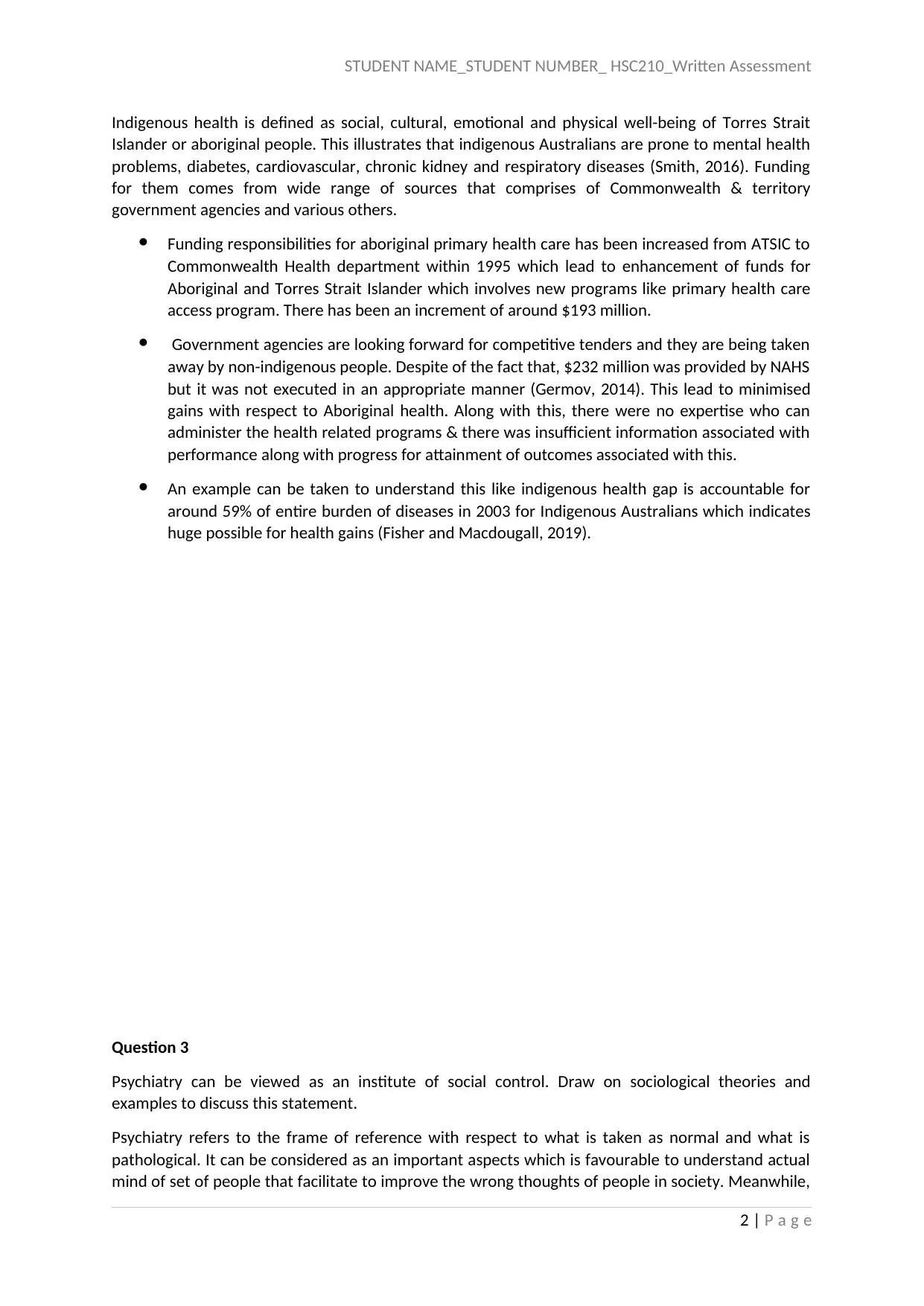
STUDENT NAME_STUDENT NUMBER_ HSC210_Written Assessment
Indigenous health is defined as social, cultural, emotional and physical well-being of Torres Strait
Islander or aboriginal people. This illustrates that indigenous Australians are prone to mental health
problems, diabetes, cardiovascular, chronic kidney and respiratory diseases (Smith, 2016). Funding
for them comes from wide range of sources that comprises of Commonwealth & territory
government agencies and various others.
Funding responsibilities for aboriginal primary health care has been increased from ATSIC to
Commonwealth Health department within 1995 which lead to enhancement of funds for
Aboriginal and Torres Strait Islander which involves new programs like primary health care
access program. There has been an increment of around $193 million.
Government agencies are looking forward for competitive tenders and they are being taken
away by non-indigenous people. Despite of the fact that, $232 million was provided by NAHS
but it was not executed in an appropriate manner (Germov, 2014). This lead to minimised
gains with respect to Aboriginal health. Along with this, there were no expertise who can
administer the health related programs & there was insufficient information associated with
performance along with progress for attainment of outcomes associated with this.
An example can be taken to understand this like indigenous health gap is accountable for
around 59% of entire burden of diseases in 2003 for Indigenous Australians which indicates
huge possible for health gains (Fisher and Macdougall, 2019).
Question 3
Psychiatry can be viewed as an institute of social control. Draw on sociological theories and
examples to discuss this statement.
Psychiatry refers to the frame of reference with respect to what is taken as normal and what is
pathological. It can be considered as an important aspects which is favourable to understand actual
mind of set of people that facilitate to improve the wrong thoughts of people in society. Meanwhile,
2 | P a g e
Indigenous health is defined as social, cultural, emotional and physical well-being of Torres Strait
Islander or aboriginal people. This illustrates that indigenous Australians are prone to mental health
problems, diabetes, cardiovascular, chronic kidney and respiratory diseases (Smith, 2016). Funding
for them comes from wide range of sources that comprises of Commonwealth & territory
government agencies and various others.
Funding responsibilities for aboriginal primary health care has been increased from ATSIC to
Commonwealth Health department within 1995 which lead to enhancement of funds for
Aboriginal and Torres Strait Islander which involves new programs like primary health care
access program. There has been an increment of around $193 million.
Government agencies are looking forward for competitive tenders and they are being taken
away by non-indigenous people. Despite of the fact that, $232 million was provided by NAHS
but it was not executed in an appropriate manner (Germov, 2014). This lead to minimised
gains with respect to Aboriginal health. Along with this, there were no expertise who can
administer the health related programs & there was insufficient information associated with
performance along with progress for attainment of outcomes associated with this.
An example can be taken to understand this like indigenous health gap is accountable for
around 59% of entire burden of diseases in 2003 for Indigenous Australians which indicates
huge possible for health gains (Fisher and Macdougall, 2019).
Question 3
Psychiatry can be viewed as an institute of social control. Draw on sociological theories and
examples to discuss this statement.
Psychiatry refers to the frame of reference with respect to what is taken as normal and what is
pathological. It can be considered as an important aspects which is favourable to understand actual
mind of set of people that facilitate to improve the wrong thoughts of people in society. Meanwhile,
2 | P a g e
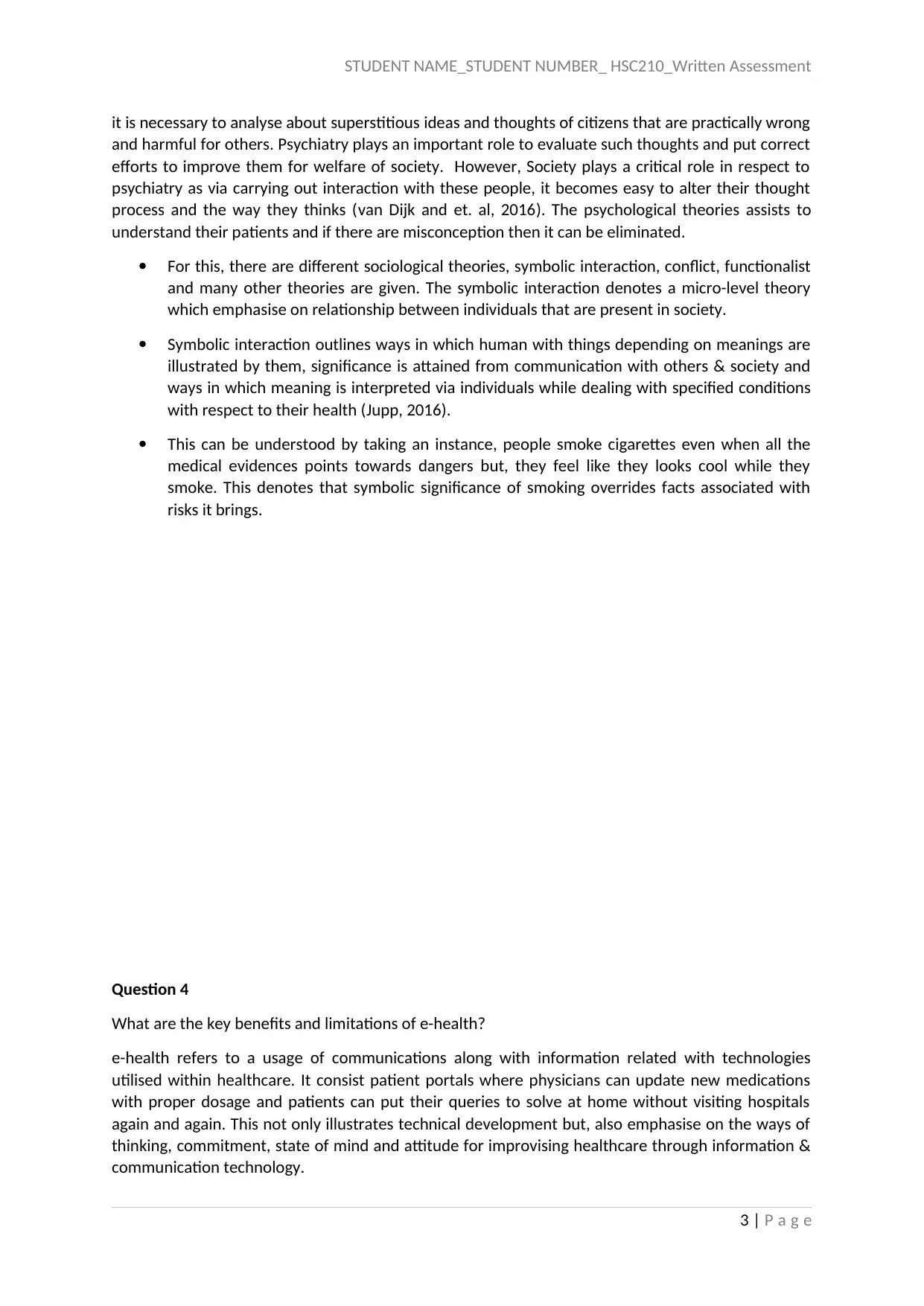
STUDENT NAME_STUDENT NUMBER_ HSC210_Written Assessment
it is necessary to analyse about superstitious ideas and thoughts of citizens that are practically wrong
and harmful for others. Psychiatry plays an important role to evaluate such thoughts and put correct
efforts to improve them for welfare of society. However, Society plays a critical role in respect to
psychiatry as via carrying out interaction with these people, it becomes easy to alter their thought
process and the way they thinks (van Dijk and et. al, 2016). The psychological theories assists to
understand their patients and if there are misconception then it can be eliminated.
For this, there are different sociological theories, symbolic interaction, conflict, functionalist
and many other theories are given. The symbolic interaction denotes a micro-level theory
which emphasise on relationship between individuals that are present in society.
Symbolic interaction outlines ways in which human with things depending on meanings are
illustrated by them, significance is attained from communication with others & society and
ways in which meaning is interpreted via individuals while dealing with specified conditions
with respect to their health (Jupp, 2016).
This can be understood by taking an instance, people smoke cigarettes even when all the
medical evidences points towards dangers but, they feel like they looks cool while they
smoke. This denotes that symbolic significance of smoking overrides facts associated with
risks it brings.
Question 4
What are the key benefits and limitations of e-health?
e-health refers to a usage of communications along with information related with technologies
utilised within healthcare. It consist patient portals where physicians can update new medications
with proper dosage and patients can put their queries to solve at home without visiting hospitals
again and again. This not only illustrates technical development but, also emphasise on the ways of
thinking, commitment, state of mind and attitude for improvising healthcare through information &
communication technology.
3 | P a g e
it is necessary to analyse about superstitious ideas and thoughts of citizens that are practically wrong
and harmful for others. Psychiatry plays an important role to evaluate such thoughts and put correct
efforts to improve them for welfare of society. However, Society plays a critical role in respect to
psychiatry as via carrying out interaction with these people, it becomes easy to alter their thought
process and the way they thinks (van Dijk and et. al, 2016). The psychological theories assists to
understand their patients and if there are misconception then it can be eliminated.
For this, there are different sociological theories, symbolic interaction, conflict, functionalist
and many other theories are given. The symbolic interaction denotes a micro-level theory
which emphasise on relationship between individuals that are present in society.
Symbolic interaction outlines ways in which human with things depending on meanings are
illustrated by them, significance is attained from communication with others & society and
ways in which meaning is interpreted via individuals while dealing with specified conditions
with respect to their health (Jupp, 2016).
This can be understood by taking an instance, people smoke cigarettes even when all the
medical evidences points towards dangers but, they feel like they looks cool while they
smoke. This denotes that symbolic significance of smoking overrides facts associated with
risks it brings.
Question 4
What are the key benefits and limitations of e-health?
e-health refers to a usage of communications along with information related with technologies
utilised within healthcare. It consist patient portals where physicians can update new medications
with proper dosage and patients can put their queries to solve at home without visiting hospitals
again and again. This not only illustrates technical development but, also emphasise on the ways of
thinking, commitment, state of mind and attitude for improvising healthcare through information &
communication technology.
3 | P a g e
⊘ This is a preview!⊘
Do you want full access?
Subscribe today to unlock all pages.

Trusted by 1+ million students worldwide
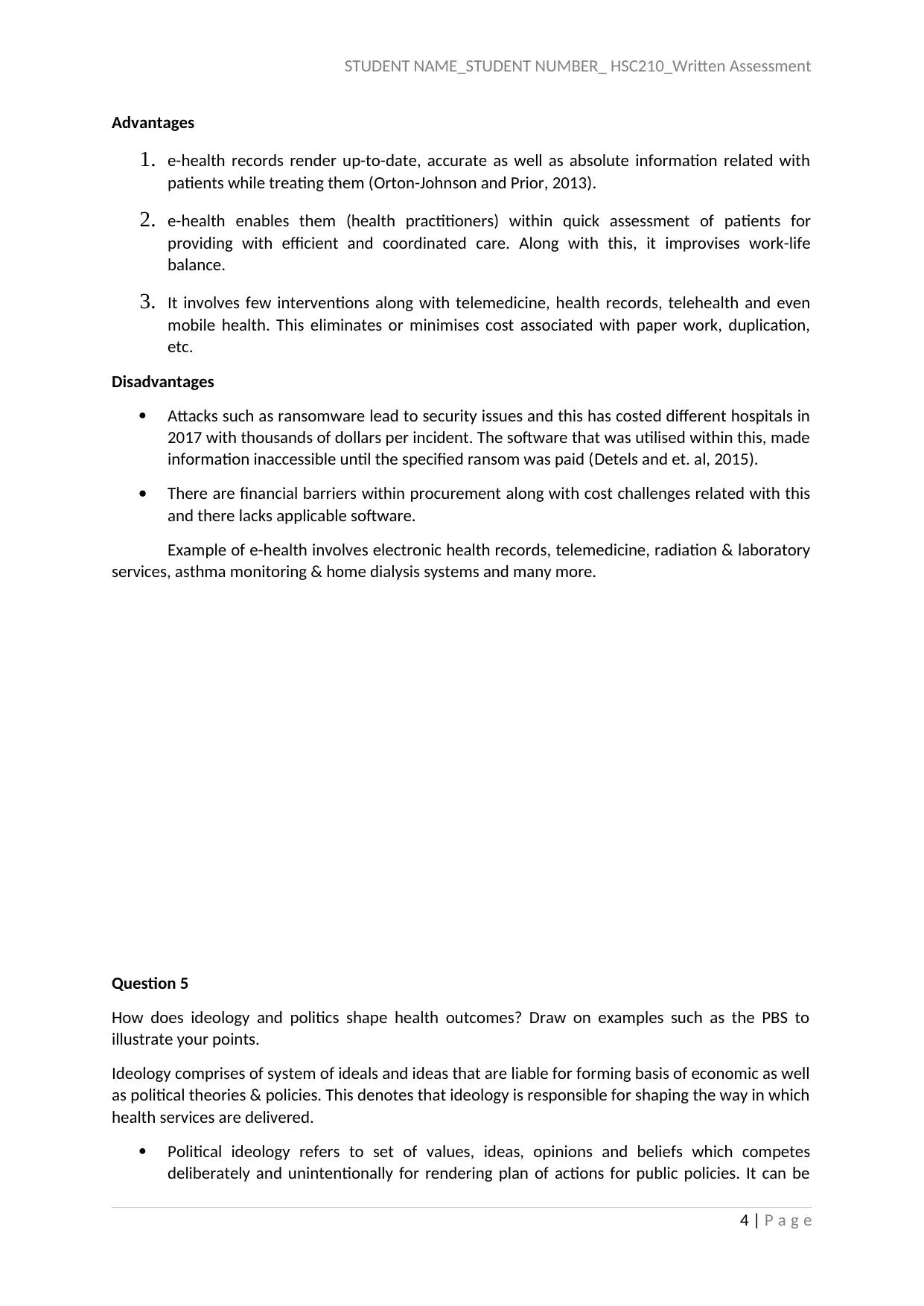
STUDENT NAME_STUDENT NUMBER_ HSC210_Written Assessment
Advantages
1. e-health records render up-to-date, accurate as well as absolute information related with
patients while treating them (Orton-Johnson and Prior, 2013).
2. e-health enables them (health practitioners) within quick assessment of patients for
providing with efficient and coordinated care. Along with this, it improvises work-life
balance.
3. It involves few interventions along with telemedicine, health records, telehealth and even
mobile health. This eliminates or minimises cost associated with paper work, duplication,
etc.
Disadvantages
Attacks such as ransomware lead to security issues and this has costed different hospitals in
2017 with thousands of dollars per incident. The software that was utilised within this, made
information inaccessible until the specified ransom was paid (Detels and et. al, 2015).
There are financial barriers within procurement along with cost challenges related with this
and there lacks applicable software.
Example of e-health involves electronic health records, telemedicine, radiation & laboratory
services, asthma monitoring & home dialysis systems and many more.
Question 5
How does ideology and politics shape health outcomes? Draw on examples such as the PBS to
illustrate your points.
Ideology comprises of system of ideals and ideas that are liable for forming basis of economic as well
as political theories & policies. This denotes that ideology is responsible for shaping the way in which
health services are delivered.
Political ideology refers to set of values, ideas, opinions and beliefs which competes
deliberately and unintentionally for rendering plan of actions for public policies. It can be
4 | P a g e
Advantages
1. e-health records render up-to-date, accurate as well as absolute information related with
patients while treating them (Orton-Johnson and Prior, 2013).
2. e-health enables them (health practitioners) within quick assessment of patients for
providing with efficient and coordinated care. Along with this, it improvises work-life
balance.
3. It involves few interventions along with telemedicine, health records, telehealth and even
mobile health. This eliminates or minimises cost associated with paper work, duplication,
etc.
Disadvantages
Attacks such as ransomware lead to security issues and this has costed different hospitals in
2017 with thousands of dollars per incident. The software that was utilised within this, made
information inaccessible until the specified ransom was paid (Detels and et. al, 2015).
There are financial barriers within procurement along with cost challenges related with this
and there lacks applicable software.
Example of e-health involves electronic health records, telemedicine, radiation & laboratory
services, asthma monitoring & home dialysis systems and many more.
Question 5
How does ideology and politics shape health outcomes? Draw on examples such as the PBS to
illustrate your points.
Ideology comprises of system of ideals and ideas that are liable for forming basis of economic as well
as political theories & policies. This denotes that ideology is responsible for shaping the way in which
health services are delivered.
Political ideology refers to set of values, ideas, opinions and beliefs which competes
deliberately and unintentionally for rendering plan of actions for public policies. It can be
4 | P a g e
Paraphrase This Document
Need a fresh take? Get an instant paraphrase of this document with our AI Paraphraser
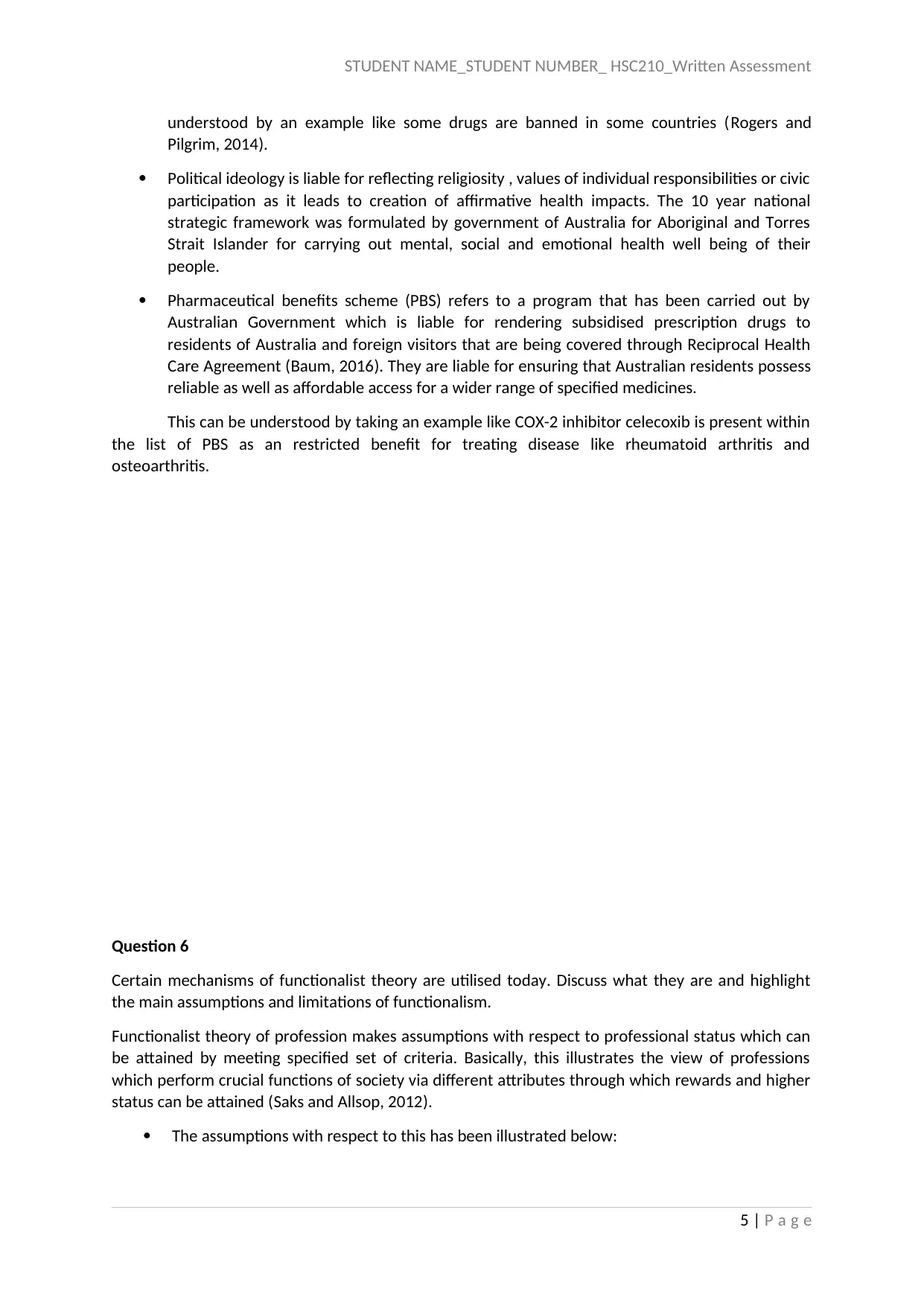
STUDENT NAME_STUDENT NUMBER_ HSC210_Written Assessment
understood by an example like some drugs are banned in some countries (Rogers and
Pilgrim, 2014).
Political ideology is liable for reflecting religiosity , values of individual responsibilities or civic
participation as it leads to creation of affirmative health impacts. The 10 year national
strategic framework was formulated by government of Australia for Aboriginal and Torres
Strait Islander for carrying out mental, social and emotional health well being of their
people.
Pharmaceutical benefits scheme (PBS) refers to a program that has been carried out by
Australian Government which is liable for rendering subsidised prescription drugs to
residents of Australia and foreign visitors that are being covered through Reciprocal Health
Care Agreement (Baum, 2016). They are liable for ensuring that Australian residents possess
reliable as well as affordable access for a wider range of specified medicines.
This can be understood by taking an example like COX-2 inhibitor celecoxib is present within
the list of PBS as an restricted benefit for treating disease like rheumatoid arthritis and
osteoarthritis.
Question 6
Certain mechanisms of functionalist theory are utilised today. Discuss what they are and highlight
the main assumptions and limitations of functionalism.
Functionalist theory of profession makes assumptions with respect to professional status which can
be attained by meeting specified set of criteria. Basically, this illustrates the view of professions
which perform crucial functions of society via different attributes through which rewards and higher
status can be attained (Saks and Allsop, 2012).
The assumptions with respect to this has been illustrated below:
5 | P a g e
understood by an example like some drugs are banned in some countries (Rogers and
Pilgrim, 2014).
Political ideology is liable for reflecting religiosity , values of individual responsibilities or civic
participation as it leads to creation of affirmative health impacts. The 10 year national
strategic framework was formulated by government of Australia for Aboriginal and Torres
Strait Islander for carrying out mental, social and emotional health well being of their
people.
Pharmaceutical benefits scheme (PBS) refers to a program that has been carried out by
Australian Government which is liable for rendering subsidised prescription drugs to
residents of Australia and foreign visitors that are being covered through Reciprocal Health
Care Agreement (Baum, 2016). They are liable for ensuring that Australian residents possess
reliable as well as affordable access for a wider range of specified medicines.
This can be understood by taking an example like COX-2 inhibitor celecoxib is present within
the list of PBS as an restricted benefit for treating disease like rheumatoid arthritis and
osteoarthritis.
Question 6
Certain mechanisms of functionalist theory are utilised today. Discuss what they are and highlight
the main assumptions and limitations of functionalism.
Functionalist theory of profession makes assumptions with respect to professional status which can
be attained by meeting specified set of criteria. Basically, this illustrates the view of professions
which perform crucial functions of society via different attributes through which rewards and higher
status can be attained (Saks and Allsop, 2012).
The assumptions with respect to this has been illustrated below:
5 | P a g e
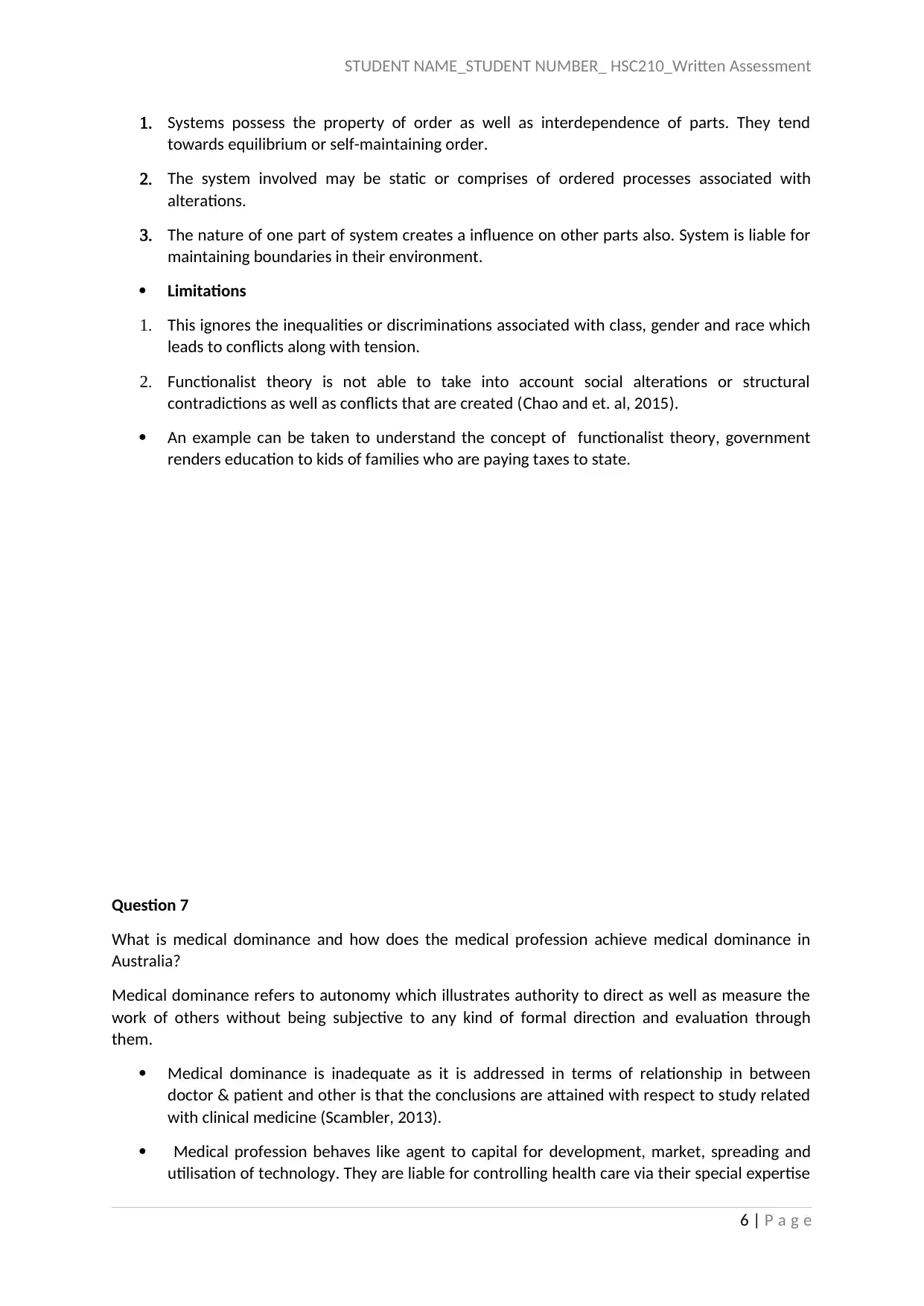
STUDENT NAME_STUDENT NUMBER_ HSC210_Written Assessment
1. Systems possess the property of order as well as interdependence of parts. They tend
towards equilibrium or self-maintaining order.
2. The system involved may be static or comprises of ordered processes associated with
alterations.
3. The nature of one part of system creates a influence on other parts also. System is liable for
maintaining boundaries in their environment.
Limitations
1. This ignores the inequalities or discriminations associated with class, gender and race which
leads to conflicts along with tension.
2. Functionalist theory is not able to take into account social alterations or structural
contradictions as well as conflicts that are created (Chao and et. al, 2015).
An example can be taken to understand the concept of functionalist theory, government
renders education to kids of families who are paying taxes to state.
Question 7
What is medical dominance and how does the medical profession achieve medical dominance in
Australia?
Medical dominance refers to autonomy which illustrates authority to direct as well as measure the
work of others without being subjective to any kind of formal direction and evaluation through
them.
Medical dominance is inadequate as it is addressed in terms of relationship in between
doctor & patient and other is that the conclusions are attained with respect to study related
with clinical medicine (Scambler, 2013).
Medical profession behaves like agent to capital for development, market, spreading and
utilisation of technology. They are liable for controlling health care via their special expertise
6 | P a g e
1. Systems possess the property of order as well as interdependence of parts. They tend
towards equilibrium or self-maintaining order.
2. The system involved may be static or comprises of ordered processes associated with
alterations.
3. The nature of one part of system creates a influence on other parts also. System is liable for
maintaining boundaries in their environment.
Limitations
1. This ignores the inequalities or discriminations associated with class, gender and race which
leads to conflicts along with tension.
2. Functionalist theory is not able to take into account social alterations or structural
contradictions as well as conflicts that are created (Chao and et. al, 2015).
An example can be taken to understand the concept of functionalist theory, government
renders education to kids of families who are paying taxes to state.
Question 7
What is medical dominance and how does the medical profession achieve medical dominance in
Australia?
Medical dominance refers to autonomy which illustrates authority to direct as well as measure the
work of others without being subjective to any kind of formal direction and evaluation through
them.
Medical dominance is inadequate as it is addressed in terms of relationship in between
doctor & patient and other is that the conclusions are attained with respect to study related
with clinical medicine (Scambler, 2013).
Medical profession behaves like agent to capital for development, market, spreading and
utilisation of technology. They are liable for controlling health care via their special expertise
6 | P a g e
⊘ This is a preview!⊘
Do you want full access?
Subscribe today to unlock all pages.

Trusted by 1+ million students worldwide
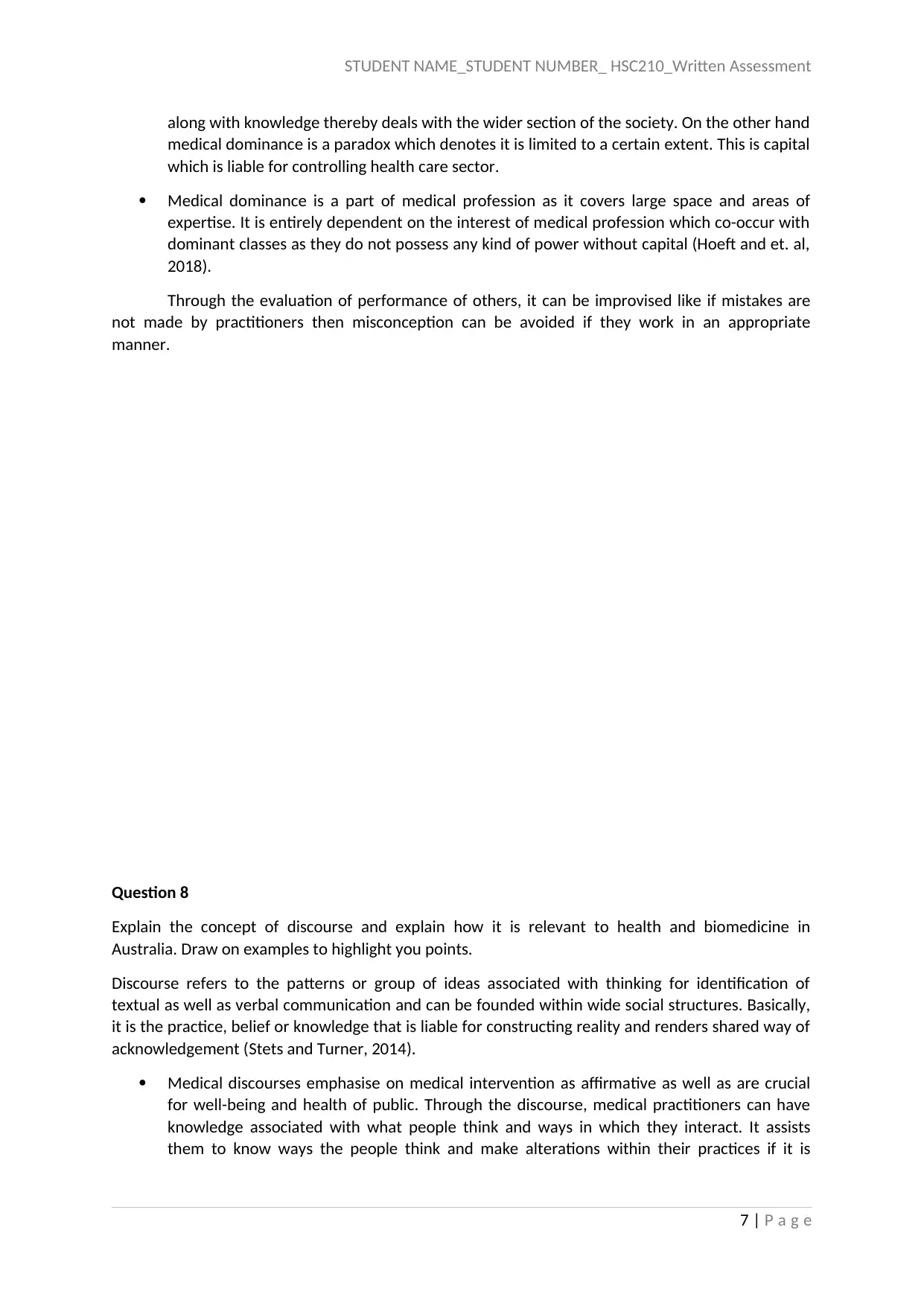
STUDENT NAME_STUDENT NUMBER_ HSC210_Written Assessment
along with knowledge thereby deals with the wider section of the society. On the other hand
medical dominance is a paradox which denotes it is limited to a certain extent. This is capital
which is liable for controlling health care sector.
Medical dominance is a part of medical profession as it covers large space and areas of
expertise. It is entirely dependent on the interest of medical profession which co-occur with
dominant classes as they do not possess any kind of power without capital (Hoeft and et. al,
2018).
Through the evaluation of performance of others, it can be improvised like if mistakes are
not made by practitioners then misconception can be avoided if they work in an appropriate
manner.
Question 8
Explain the concept of discourse and explain how it is relevant to health and biomedicine in
Australia. Draw on examples to highlight you points.
Discourse refers to the patterns or group of ideas associated with thinking for identification of
textual as well as verbal communication and can be founded within wide social structures. Basically,
it is the practice, belief or knowledge that is liable for constructing reality and renders shared way of
acknowledgement (Stets and Turner, 2014).
Medical discourses emphasise on medical intervention as affirmative as well as are crucial
for well-being and health of public. Through the discourse, medical practitioners can have
knowledge associated with what people think and ways in which they interact. It assists
them to know ways the people think and make alterations within their practices if it is
7 | P a g e
along with knowledge thereby deals with the wider section of the society. On the other hand
medical dominance is a paradox which denotes it is limited to a certain extent. This is capital
which is liable for controlling health care sector.
Medical dominance is a part of medical profession as it covers large space and areas of
expertise. It is entirely dependent on the interest of medical profession which co-occur with
dominant classes as they do not possess any kind of power without capital (Hoeft and et. al,
2018).
Through the evaluation of performance of others, it can be improvised like if mistakes are
not made by practitioners then misconception can be avoided if they work in an appropriate
manner.
Question 8
Explain the concept of discourse and explain how it is relevant to health and biomedicine in
Australia. Draw on examples to highlight you points.
Discourse refers to the patterns or group of ideas associated with thinking for identification of
textual as well as verbal communication and can be founded within wide social structures. Basically,
it is the practice, belief or knowledge that is liable for constructing reality and renders shared way of
acknowledgement (Stets and Turner, 2014).
Medical discourses emphasise on medical intervention as affirmative as well as are crucial
for well-being and health of public. Through the discourse, medical practitioners can have
knowledge associated with what people think and ways in which they interact. It assists
them to know ways the people think and make alterations within their practices if it is
7 | P a g e
Paraphrase This Document
Need a fresh take? Get an instant paraphrase of this document with our AI Paraphraser
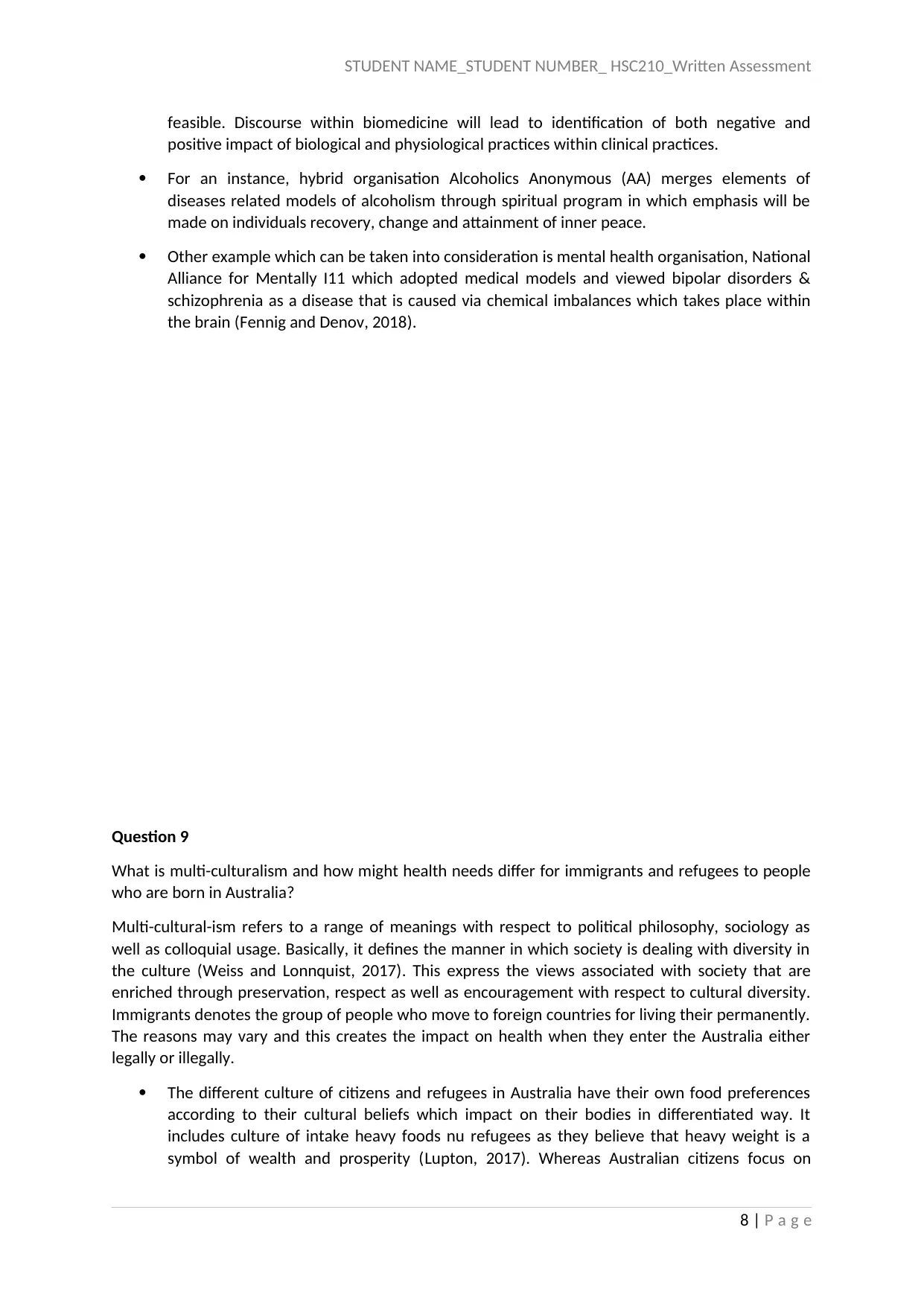
STUDENT NAME_STUDENT NUMBER_ HSC210_Written Assessment
feasible. Discourse within biomedicine will lead to identification of both negative and
positive impact of biological and physiological practices within clinical practices.
For an instance, hybrid organisation Alcoholics Anonymous (AA) merges elements of
diseases related models of alcoholism through spiritual program in which emphasis will be
made on individuals recovery, change and attainment of inner peace.
Other example which can be taken into consideration is mental health organisation, National
Alliance for Mentally I11 which adopted medical models and viewed bipolar disorders &
schizophrenia as a disease that is caused via chemical imbalances which takes place within
the brain (Fennig and Denov, 2018).
Question 9
What is multi-culturalism and how might health needs differ for immigrants and refugees to people
who are born in Australia?
Multi-cultural-ism refers to a range of meanings with respect to political philosophy, sociology as
well as colloquial usage. Basically, it defines the manner in which society is dealing with diversity in
the culture (Weiss and Lonnquist, 2017). This express the views associated with society that are
enriched through preservation, respect as well as encouragement with respect to cultural diversity.
Immigrants denotes the group of people who move to foreign countries for living their permanently.
The reasons may vary and this creates the impact on health when they enter the Australia either
legally or illegally.
The different culture of citizens and refugees in Australia have their own food preferences
according to their cultural beliefs which impact on their bodies in differentiated way. It
includes culture of intake heavy foods nu refugees as they believe that heavy weight is a
symbol of wealth and prosperity (Lupton, 2017). Whereas Australian citizens focus on
8 | P a g e
feasible. Discourse within biomedicine will lead to identification of both negative and
positive impact of biological and physiological practices within clinical practices.
For an instance, hybrid organisation Alcoholics Anonymous (AA) merges elements of
diseases related models of alcoholism through spiritual program in which emphasis will be
made on individuals recovery, change and attainment of inner peace.
Other example which can be taken into consideration is mental health organisation, National
Alliance for Mentally I11 which adopted medical models and viewed bipolar disorders &
schizophrenia as a disease that is caused via chemical imbalances which takes place within
the brain (Fennig and Denov, 2018).
Question 9
What is multi-culturalism and how might health needs differ for immigrants and refugees to people
who are born in Australia?
Multi-cultural-ism refers to a range of meanings with respect to political philosophy, sociology as
well as colloquial usage. Basically, it defines the manner in which society is dealing with diversity in
the culture (Weiss and Lonnquist, 2017). This express the views associated with society that are
enriched through preservation, respect as well as encouragement with respect to cultural diversity.
Immigrants denotes the group of people who move to foreign countries for living their permanently.
The reasons may vary and this creates the impact on health when they enter the Australia either
legally or illegally.
The different culture of citizens and refugees in Australia have their own food preferences
according to their cultural beliefs which impact on their bodies in differentiated way. It
includes culture of intake heavy foods nu refugees as they believe that heavy weight is a
symbol of wealth and prosperity (Lupton, 2017). Whereas Australian citizens focus on
8 | P a g e
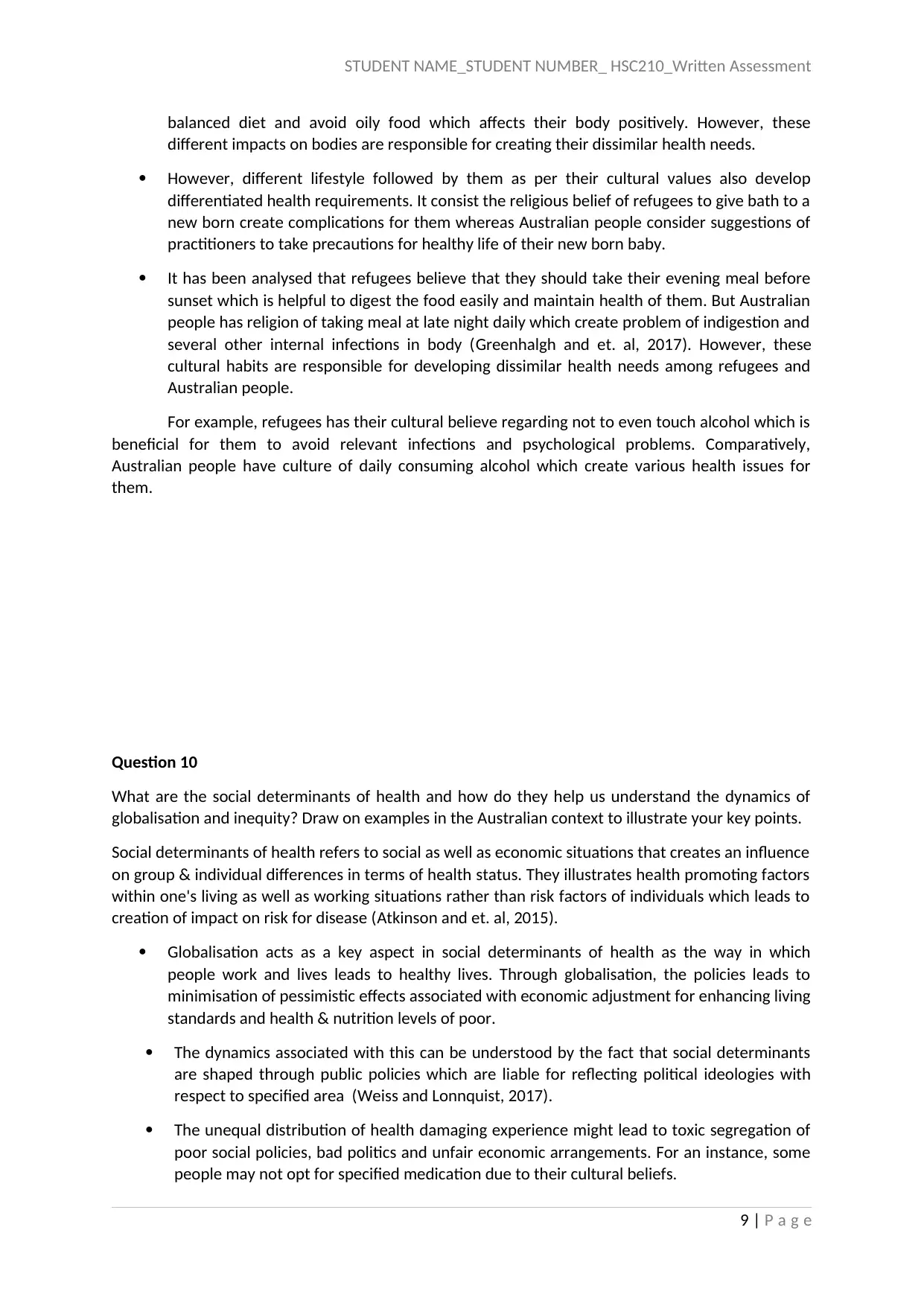
STUDENT NAME_STUDENT NUMBER_ HSC210_Written Assessment
balanced diet and avoid oily food which affects their body positively. However, these
different impacts on bodies are responsible for creating their dissimilar health needs.
However, different lifestyle followed by them as per their cultural values also develop
differentiated health requirements. It consist the religious belief of refugees to give bath to a
new born create complications for them whereas Australian people consider suggestions of
practitioners to take precautions for healthy life of their new born baby.
It has been analysed that refugees believe that they should take their evening meal before
sunset which is helpful to digest the food easily and maintain health of them. But Australian
people has religion of taking meal at late night daily which create problem of indigestion and
several other internal infections in body (Greenhalgh and et. al, 2017). However, these
cultural habits are responsible for developing dissimilar health needs among refugees and
Australian people.
For example, refugees has their cultural believe regarding not to even touch alcohol which is
beneficial for them to avoid relevant infections and psychological problems. Comparatively,
Australian people have culture of daily consuming alcohol which create various health issues for
them.
Question 10
What are the social determinants of health and how do they help us understand the dynamics of
globalisation and inequity? Draw on examples in the Australian context to illustrate your key points.
Social determinants of health refers to social as well as economic situations that creates an influence
on group & individual differences in terms of health status. They illustrates health promoting factors
within one's living as well as working situations rather than risk factors of individuals which leads to
creation of impact on risk for disease (Atkinson and et. al, 2015).
Globalisation acts as a key aspect in social determinants of health as the way in which
people work and lives leads to healthy lives. Through globalisation, the policies leads to
minimisation of pessimistic effects associated with economic adjustment for enhancing living
standards and health & nutrition levels of poor.
The dynamics associated with this can be understood by the fact that social determinants
are shaped through public policies which are liable for reflecting political ideologies with
respect to specified area (Weiss and Lonnquist, 2017).
The unequal distribution of health damaging experience might lead to toxic segregation of
poor social policies, bad politics and unfair economic arrangements. For an instance, some
people may not opt for specified medication due to their cultural beliefs.
9 | P a g e
balanced diet and avoid oily food which affects their body positively. However, these
different impacts on bodies are responsible for creating their dissimilar health needs.
However, different lifestyle followed by them as per their cultural values also develop
differentiated health requirements. It consist the religious belief of refugees to give bath to a
new born create complications for them whereas Australian people consider suggestions of
practitioners to take precautions for healthy life of their new born baby.
It has been analysed that refugees believe that they should take their evening meal before
sunset which is helpful to digest the food easily and maintain health of them. But Australian
people has religion of taking meal at late night daily which create problem of indigestion and
several other internal infections in body (Greenhalgh and et. al, 2017). However, these
cultural habits are responsible for developing dissimilar health needs among refugees and
Australian people.
For example, refugees has their cultural believe regarding not to even touch alcohol which is
beneficial for them to avoid relevant infections and psychological problems. Comparatively,
Australian people have culture of daily consuming alcohol which create various health issues for
them.
Question 10
What are the social determinants of health and how do they help us understand the dynamics of
globalisation and inequity? Draw on examples in the Australian context to illustrate your key points.
Social determinants of health refers to social as well as economic situations that creates an influence
on group & individual differences in terms of health status. They illustrates health promoting factors
within one's living as well as working situations rather than risk factors of individuals which leads to
creation of impact on risk for disease (Atkinson and et. al, 2015).
Globalisation acts as a key aspect in social determinants of health as the way in which
people work and lives leads to healthy lives. Through globalisation, the policies leads to
minimisation of pessimistic effects associated with economic adjustment for enhancing living
standards and health & nutrition levels of poor.
The dynamics associated with this can be understood by the fact that social determinants
are shaped through public policies which are liable for reflecting political ideologies with
respect to specified area (Weiss and Lonnquist, 2017).
The unequal distribution of health damaging experience might lead to toxic segregation of
poor social policies, bad politics and unfair economic arrangements. For an instance, some
people may not opt for specified medication due to their cultural beliefs.
9 | P a g e
⊘ This is a preview!⊘
Do you want full access?
Subscribe today to unlock all pages.

Trusted by 1+ million students worldwide
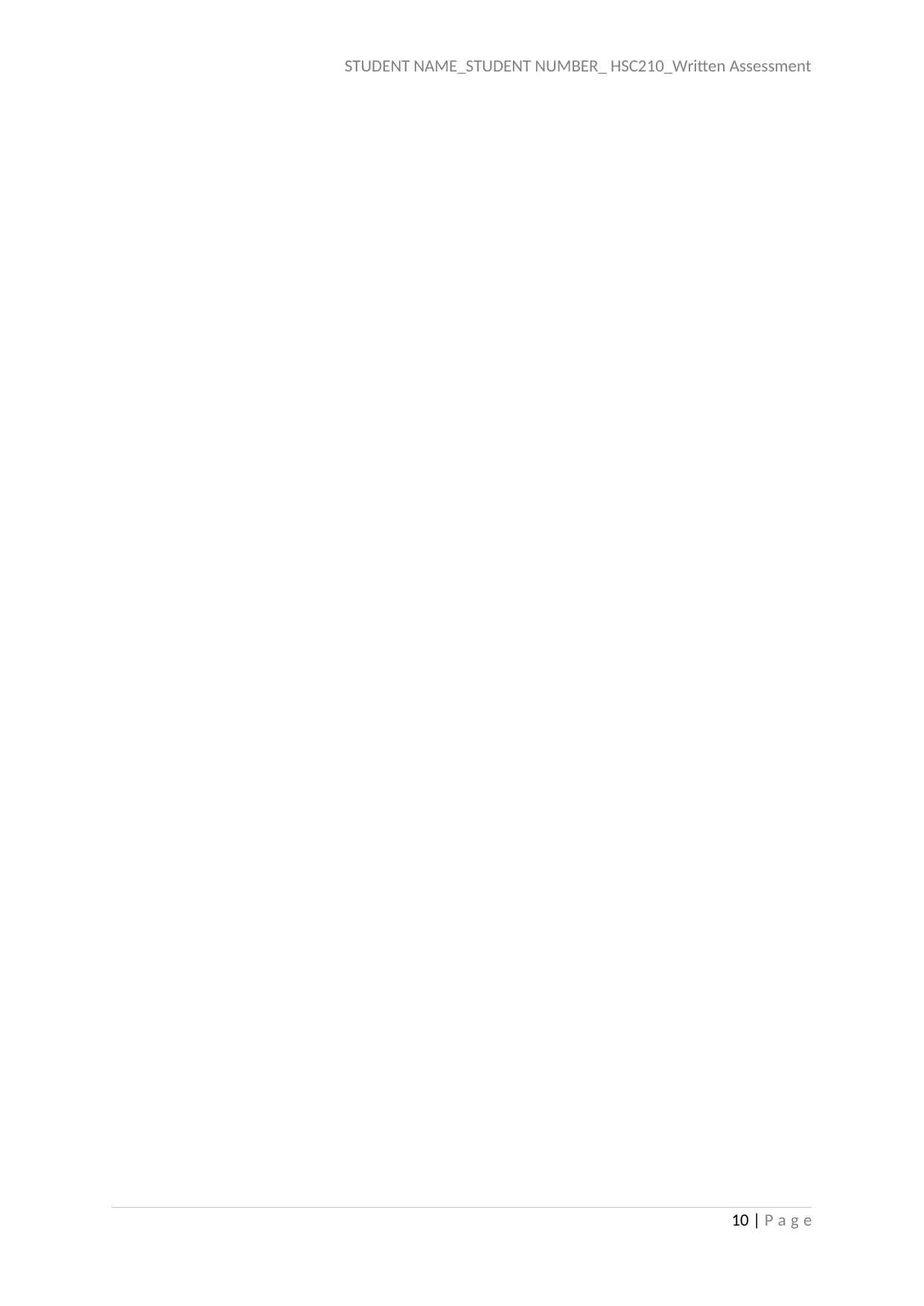
STUDENT NAME_STUDENT NUMBER_ HSC210_Written Assessment
10 | P a g e
10 | P a g e
Paraphrase This Document
Need a fresh take? Get an instant paraphrase of this document with our AI Paraphraser
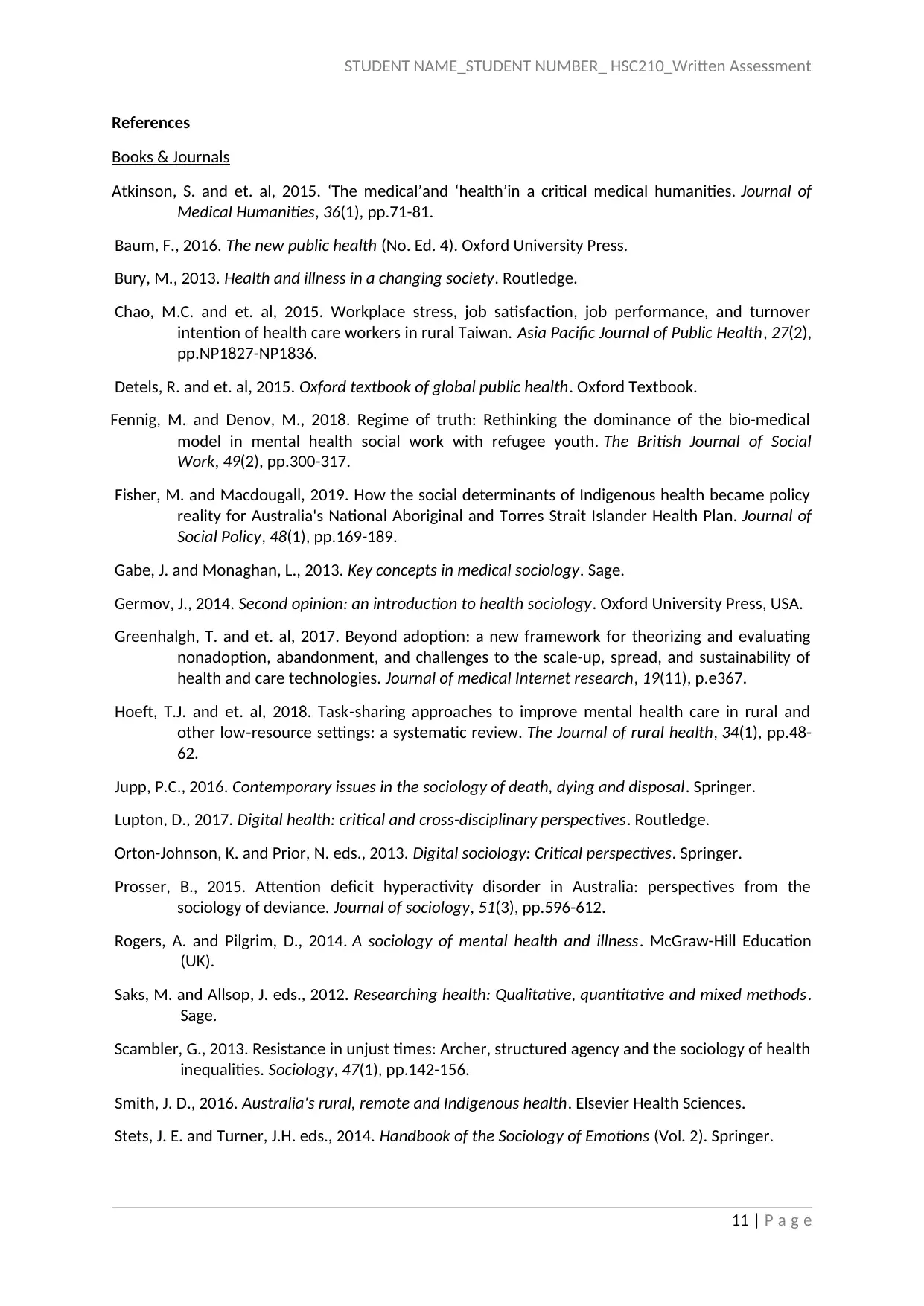
STUDENT NAME_STUDENT NUMBER_ HSC210_Written Assessment
References
Books & Journals
Atkinson, S. and et. al, 2015. ‘The medical’and ‘health’in a critical medical humanities. Journal of
Medical Humanities, 36(1), pp.71-81.
Baum, F., 2016. The new public health (No. Ed. 4). Oxford University Press.
Bury, M., 2013. Health and illness in a changing society. Routledge.
Chao, M.C. and et. al, 2015. Workplace stress, job satisfaction, job performance, and turnover
intention of health care workers in rural Taiwan. Asia Pacific Journal of Public Health, 27(2),
pp.NP1827-NP1836.
Detels, R. and et. al, 2015. Oxford textbook of global public health. Oxford Textbook.
Fennig, M. and Denov, M., 2018. Regime of truth: Rethinking the dominance of the bio-medical
model in mental health social work with refugee youth. The British Journal of Social
Work, 49(2), pp.300-317.
Fisher, M. and Macdougall, 2019. How the social determinants of Indigenous health became policy
reality for Australia's National Aboriginal and Torres Strait Islander Health Plan. Journal of
Social Policy, 48(1), pp.169-189.
Gabe, J. and Monaghan, L., 2013. Key concepts in medical sociology. Sage.
Germov, J., 2014. Second opinion: an introduction to health sociology. Oxford University Press, USA.
Greenhalgh, T. and et. al, 2017. Beyond adoption: a new framework for theorizing and evaluating
nonadoption, abandonment, and challenges to the scale-up, spread, and sustainability of
health and care technologies. Journal of medical Internet research, 19(11), p.e367.
Hoeft, T.J. and et. al, 2018. Task sharing approaches to improve mental health care in rural and‐
other low resource settings: a systematic review.‐ The Journal of rural health, 34(1), pp.48-
62.
Jupp, P.C., 2016. Contemporary issues in the sociology of death, dying and disposal. Springer.
Lupton, D., 2017. Digital health: critical and cross-disciplinary perspectives. Routledge.
Orton-Johnson, K. and Prior, N. eds., 2013. Digital sociology: Critical perspectives. Springer.
Prosser, B., 2015. Attention deficit hyperactivity disorder in Australia: perspectives from the
sociology of deviance. Journal of sociology, 51(3), pp.596-612.
Rogers, A. and Pilgrim, D., 2014. A sociology of mental health and illness. McGraw-Hill Education
(UK).
Saks, M. and Allsop, J. eds., 2012. Researching health: Qualitative, quantitative and mixed methods.
Sage.
Scambler, G., 2013. Resistance in unjust times: Archer, structured agency and the sociology of health
inequalities. Sociology, 47(1), pp.142-156.
Smith, J. D., 2016. Australia's rural, remote and Indigenous health. Elsevier Health Sciences.
Stets, J. E. and Turner, J.H. eds., 2014. Handbook of the Sociology of Emotions (Vol. 2). Springer.
11 | P a g e
References
Books & Journals
Atkinson, S. and et. al, 2015. ‘The medical’and ‘health’in a critical medical humanities. Journal of
Medical Humanities, 36(1), pp.71-81.
Baum, F., 2016. The new public health (No. Ed. 4). Oxford University Press.
Bury, M., 2013. Health and illness in a changing society. Routledge.
Chao, M.C. and et. al, 2015. Workplace stress, job satisfaction, job performance, and turnover
intention of health care workers in rural Taiwan. Asia Pacific Journal of Public Health, 27(2),
pp.NP1827-NP1836.
Detels, R. and et. al, 2015. Oxford textbook of global public health. Oxford Textbook.
Fennig, M. and Denov, M., 2018. Regime of truth: Rethinking the dominance of the bio-medical
model in mental health social work with refugee youth. The British Journal of Social
Work, 49(2), pp.300-317.
Fisher, M. and Macdougall, 2019. How the social determinants of Indigenous health became policy
reality for Australia's National Aboriginal and Torres Strait Islander Health Plan. Journal of
Social Policy, 48(1), pp.169-189.
Gabe, J. and Monaghan, L., 2013. Key concepts in medical sociology. Sage.
Germov, J., 2014. Second opinion: an introduction to health sociology. Oxford University Press, USA.
Greenhalgh, T. and et. al, 2017. Beyond adoption: a new framework for theorizing and evaluating
nonadoption, abandonment, and challenges to the scale-up, spread, and sustainability of
health and care technologies. Journal of medical Internet research, 19(11), p.e367.
Hoeft, T.J. and et. al, 2018. Task sharing approaches to improve mental health care in rural and‐
other low resource settings: a systematic review.‐ The Journal of rural health, 34(1), pp.48-
62.
Jupp, P.C., 2016. Contemporary issues in the sociology of death, dying and disposal. Springer.
Lupton, D., 2017. Digital health: critical and cross-disciplinary perspectives. Routledge.
Orton-Johnson, K. and Prior, N. eds., 2013. Digital sociology: Critical perspectives. Springer.
Prosser, B., 2015. Attention deficit hyperactivity disorder in Australia: perspectives from the
sociology of deviance. Journal of sociology, 51(3), pp.596-612.
Rogers, A. and Pilgrim, D., 2014. A sociology of mental health and illness. McGraw-Hill Education
(UK).
Saks, M. and Allsop, J. eds., 2012. Researching health: Qualitative, quantitative and mixed methods.
Sage.
Scambler, G., 2013. Resistance in unjust times: Archer, structured agency and the sociology of health
inequalities. Sociology, 47(1), pp.142-156.
Smith, J. D., 2016. Australia's rural, remote and Indigenous health. Elsevier Health Sciences.
Stets, J. E. and Turner, J.H. eds., 2014. Handbook of the Sociology of Emotions (Vol. 2). Springer.
11 | P a g e
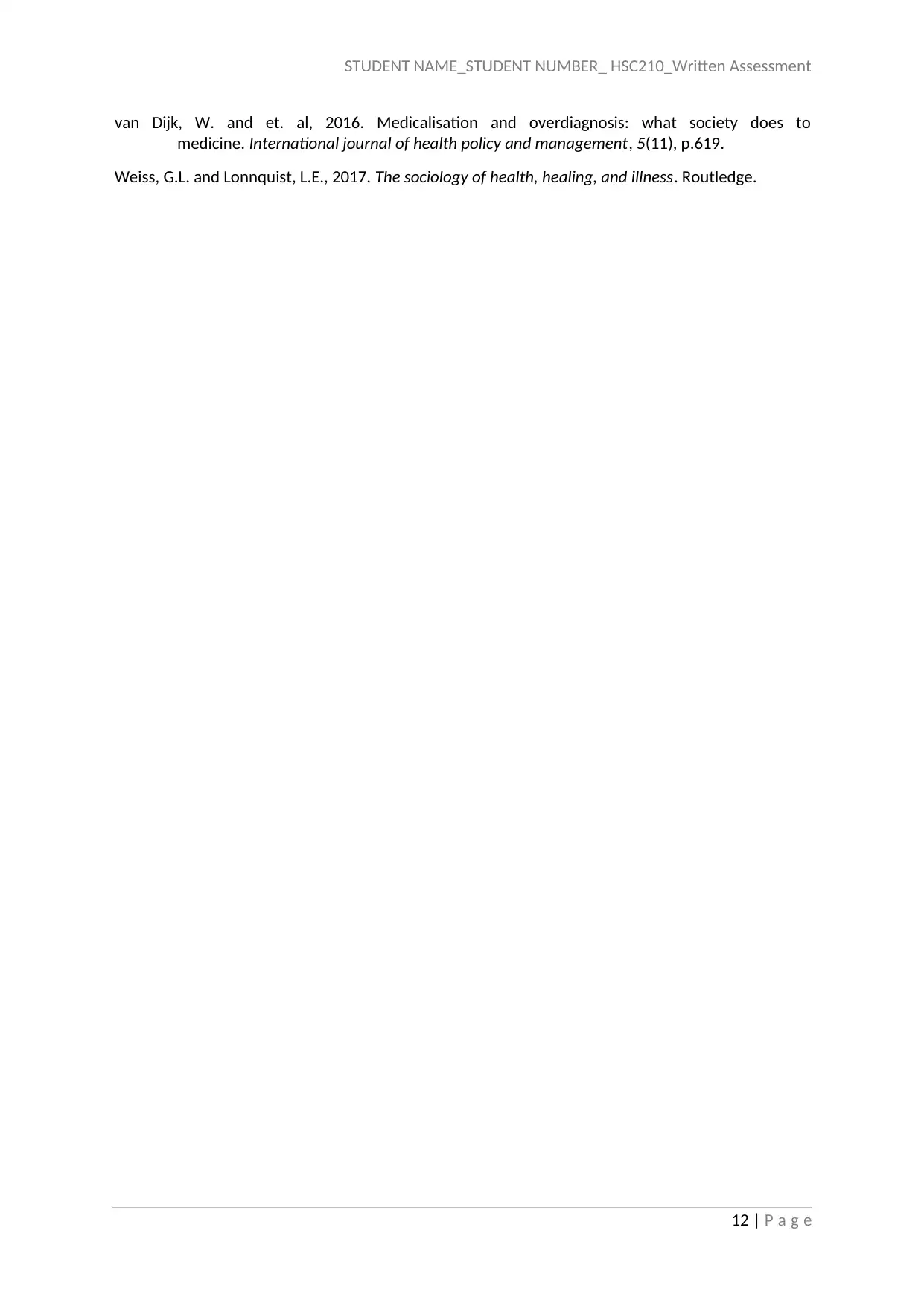
STUDENT NAME_STUDENT NUMBER_ HSC210_Written Assessment
van Dijk, W. and et. al, 2016. Medicalisation and overdiagnosis: what society does to
medicine. International journal of health policy and management, 5(11), p.619.
Weiss, G.L. and Lonnquist, L.E., 2017. The sociology of health, healing, and illness. Routledge.
12 | P a g e
van Dijk, W. and et. al, 2016. Medicalisation and overdiagnosis: what society does to
medicine. International journal of health policy and management, 5(11), p.619.
Weiss, G.L. and Lonnquist, L.E., 2017. The sociology of health, healing, and illness. Routledge.
12 | P a g e
⊘ This is a preview!⊘
Do you want full access?
Subscribe today to unlock all pages.

Trusted by 1+ million students worldwide
1 out of 12
Related Documents
Your All-in-One AI-Powered Toolkit for Academic Success.
+13062052269
info@desklib.com
Available 24*7 on WhatsApp / Email
![[object Object]](/_next/static/media/star-bottom.7253800d.svg)
Unlock your academic potential
Copyright © 2020–2025 A2Z Services. All Rights Reserved. Developed and managed by ZUCOL.





